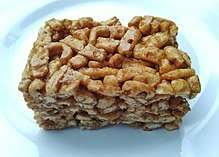Sachima
 Sachima |
| Alternative names |
Shāqímǎ |
|---|
| Type |
Pastry |
|---|
| Place of origin |
China |
|---|
| Main ingredients |
Flour, butter, rock sugar |
|---|
| Variations |
by region including raisins, sesame, coconut, etc |
|---|
|
|
Sachima (Manchu: ᠰᠠᠴᡳᠮᠠ; Möllendorff: sacima; Abkai: saqima), also called sàqímǎ or shāqímǎ, is a common Chinese pastry, originated among Manchus in Northeast China. Sachima has spread throughout all of China. Its decoration and flavor vary in different regional Chinese cuisine, but the appearance of all versions is essentially the same. It is made of fluffy strands of fried batter bound together with a stiff sugar syrup, showing similarity to American Rice Krispies Treats.
Cantonese
The Cantonese pastry version of sachima is slightly sweet. It is also made of essentially the same ingredients as the other varieties of sachima. It is often sprinkled with sesame seeds, raisins or dried coconut. The Cantonese variety of sachima ranges from chewy to crunchy in texture. Most overseas Chinatowns offer the Cantonese style of the pastry. It is commonly found in Hong Kong.
Fujian
Many of the Fujian distribution companies manufacture packaged versions of Sachima. This version has sesame and is made of wheat flour, vegetable oil, egg, milk, granular sugar, and malt sugar.[1] The taste is comparatively plain compared to the more sweetened Cantonese version.
References
 |
Wikimedia Commons has media related to Shaqima. |
|
|---|
| Types | |
|---|
| General | |
|---|
| Poppy seed | |
|---|
| Chinese | |
|---|
| French | |
|---|
| Greek | |
|---|
| Iranian | |
|---|
| Italian | |
|---|
| Romanian | |
|---|
| Swiss | |
|---|
| Turkish | |
|---|
Related
topics | |
|---|
|
